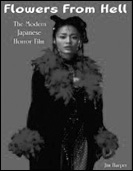Flowers From Hell: The Modern Japanese Horror Film
by Jasper Sharp
Kiyoshi Kurosawa is one of the many directors whose films fall under the spotlight in Jim Harper's admirably broad overview of Japanese horror, Flowers From Hell, although frustratingly the author rather cops out in his introduction, denying Kurosawa the chapter he most certainly deserves with the disclaimer that his "auteurist approach makes it difficult to create a credible overview of his work without covering his many non-horror efforts; he simply cannot be assessed effectively from a purely horror perspective." [pg 9] Well, that's possibly true, but given that most of the reviews I've seen for the recent UK release of Tokyo Sonata misleadingly assert that the director's latest is a radical departure into non-genre territory, while those familiar with his back catalogue are more likely to view it in terms of a similar approach applied to issues more solidly grounded in the real world, surely some sort of analysis as to what makes Kurosawa's horror films "horror" and what sets them aside from his other works like License to Live, Barren Illusion and Bright Future might bring its own insights into how one defines horror as a cinematic genre.
To be fair, however, theorizing and formal analysis is not really what Harper's book is about (one notes the lack of footnotes and citations, for example). In this respect, it comes as something of a breath of fresh air - far too much recent writing about Japanese horror, especially in the academic field, has had a tendency to stumble into rather awkward territory in its attempts at drawing conclusions about what these films say about contemporary Japanese society.
Instead, what we have is a more straightforward overview of what's out there, giving a fuller impression of the range of films that make up the J-horror genre. Indeed, what Flowers From Hell lacks in depth, it certainly makes up for in breadth. In its nine chapters, whose headings include "Vengeful Spirits"; "The 1980s: Splatter and Beyond", "Hideo Nakata and the Ring Cycle", "Love and Mutation: The Works of Junji Ito on Film" and "The Post-Juon Horror Film", alongside the obvious titles that regularly come up for discussion (Ring, Audition, Juon, etc), there's also more off-the-radar stuff like Masayuki Ochiai's Hypnosis (1999), Toshiharu Ikeda's The Man Behind the Scissors (2004), Ryu Kaneda's Boogiepop and Others (2000) and Joji Matsuoka's Phantom of the Toilet (1995). You can't help but admire Harper's stamina - he's certainly seen one hell of a lot of films. Whether there's anything interesting to say about the likes of St John's Wort (2001) is another matter, which probably accounts for why much of the book consists of plot summaries and background info about what else the various cast and crew members have done, but little beyond that. It's an entertaining enough read, if not particularly challenging or insightful, and should prove useful for horror fans looking to expand their collections beyond the more familiar touchstones.
With this in mind, I've got two main criticisms. Firstly, and perhaps unsurprisingly given that Harper's sphere of expertise is horror, not Japanese film (he previous wrote Legacy of Blood: A Comprehensive Guide to Slasher Movies, published in 2004), there's the odd typo and mis-transliteration of the Japanese, though none of this is too heinous given the target audience, and doesn't distort the picture of the genre he's trying to present. For example, the original title of Norio Tsuruta's Real True Scary Stories (1991), 'Honto ni atta kowai hanashi', is given as 'Honto ni atta kawai hanashi' (dangerously close to 'Real Cute Stories'!), and again, there's the usual confusion about Nikkatsu's Roman Porno films being pink eiga. Secondly, the coverage is predominately post-1980s films, with no attempt to hark back to the origins of the genre, the various Ghost Cat and Ghost of Yotsuya titles from the 1920s and 1930s. This might be explained by the sheer difficulty in getting access to those titles that survive from the pre-war period, and one assumes that the author is more interested in pointing the reader to what's currently out there on DVD. That said, I would have thought the films of Nobuo Nakagawa might be worth a bit more investigation, but I guess that given the book's sub-title is "The Modern Japanese Horror Film", one shouldn't really gripe.
These reservations aside, along with the relevant chapters of Dennis Meikle's The Ring Companion, Flowers From Hell is about the best guide for casual readers as to what's out there, and both books prove that topics such as J-Horror are far better served by genre fans than by academics.
